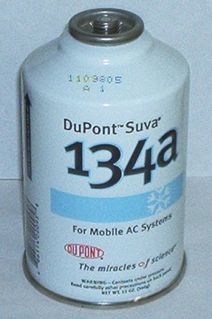
The World Wide Web (WWW), commonly known as the Web, is an information system where documents and other web resources are identified by Uniform Resource Locators, which may be interlinked by hyperlinks, and are accessible over the Internet. The resources of the Web are transferred via the Hypertext Transfer Protocol (HTTP), may be accessed by users by a software application called a web browser, and are published by a software application called a web server. The World Wide Web is not synonymous with the Internet, which pre-dated the Web in some form by over two decades and upon the technologies of which the Web is built.

A heat pump is a system used to heat or cool an enclosed space or domestic water by transferring thermal energy from a cooler space to a warmer space using the refrigeration cycle, moving heat in the opposite direction in which heat transfer would take place without the application of external power. When used to cool a building, a heat pump works like an air conditioner by transferring heat from inside the building to the outdoors. When used to heat a building, the heat pump operates in reverse: heat is transferred into the building from the outdoors. Common heat pump types are air source heat pumps, ground source heat pumps, water source heat pumps and exhaust air heat pumps. Heat pumps are also often used in district heating systems.

Chemical Abstracts Service (CAS) is a division of the American Chemical Society. It is a source of chemical information. CAS is located in Columbus, Ohio, United States.

A refrigerant is a working fluid used in the refrigeration cycle of air conditioning systems and heat pumps where in most cases they undergo a repeated phase transition from a liquid to a gas and back again. Refrigerants are heavily regulated due to their toxicity, flammability and the contribution of CFC and HCFC refrigerants to ozone depletion and that of HFC refrigerants to climate change.

A drying oil is an oil that hardens to a tough, solid film after a period of exposure to air, at room temperature. The oil hardens through a chemical reaction in which the components crosslink by the action of oxygen. Drying oils are a key component of oil paint and some varnishes. Some commonly used drying oils include linseed oil, tung oil, poppy seed oil, perilla oil, and walnut oil. Their use has declined over the past several decades, as they have been replaced by alkyd resins and other binders.

A chiller is a machine that removes heat from a liquid coolant via a vapor-compression, adsorption refrigeration, or absorption refrigeration cycles. This liquid can then be circulated through a heat exchanger to cool equipment, or another process stream. As a necessary by-product, refrigeration creates waste heat that must be exhausted to ambience, or for greater efficiency, recovered for heating purposes. Vapor compression chillers may use any of a number of different types of compressors. Most common today are the hermetic scroll, semi-hermetic screw, or centrifugal compressors. The condensing side of the chiller can be either air or water cooled. Even when liquid cooled, the chiller is often cooled by an induced or forced draft cooling tower. Absorption and adsorption chillers require a heat source to function.
In physics, energy density is the amount of energy stored in a given system or region of space per unit volume. It may also be used for energy per unit mass, though a more accurate term for this is specific energy.

A phase change material (PCM) is a substance which releases/absorbs sufficient energy at phase transition to provide useful heat/cooling. Generally the transition will be from one of the first two fundamental states of matter - solid and liquid - to the other. The phase transition may also be between non-classical states of matter, such as the conformity of crystals, where the material goes from conforming to one crystalline structure to conforming to another, which may be a higher or lower energy state.
HP OMEN is a line of high-end gaming PC manufactured by HP Inc. From what was known as Voodoo PC, it was founded in 1991, and acquired by Hewlett Packard in 2006. Voodoo specialized in high desktop performance computing. By 2013 the Voodoo name was no longer used, and was replaced by the brand name Omen, which used the same logo until 2020.

An ice pack or gel pack is a portable plastic bag filled with water, refrigerant gel, or liquid. To be prepared for use, the pack is first placed in a freezer. Both ice and other non-toxic refrigerants can absorb a considerable amount of heat before they warm above 0 °C (32 °F) used to keep food cool in portable coolers, or as a cold compress to alleviate the pain of minor injuries, or in insulated shipping containers to keep products cool during transport.
RDFa or Resource Description Framework in Attributes is a W3C Recommendation that adds a set of attribute-level extensions to HTML, XHTML and various XML-based document types for embedding rich metadata within Web documents. The Resource Description Framework (RDF) data-model mapping enables its use for embedding RDF subject-predicate-object expressions within XHTML documents. It also enables the extraction of RDF model triples by compliant user agents.

An absorption heat pump (AHP) is a heat pump driven by thermal energy such as combustion of natural gas, steam solar-heated water, air or geothermal-heated water differently from compression heat pumps that are driven by mechanical energy. AHPs are more complex and require larger units compared to compression heat pumps. In particular, the lower electricity demand of such heat pumps is related to the liquid pumping only. Their applications are restricted to those cases when electricity is extremely expensive or a large amount of unutilized heat at suitable temperatures is available and when the cooling or heating output has a greater value than heat input consumed. Absorption refrigerators also work on the same principle, but are not reversible and cannot serve as a heat source.

Antero Manninen, also known as ‘‘‘Mr. Cool’’’, is a session musician and former band member of Finnish Cello metal quartet Apocalyptica. He was an official member but did not write the music and left in 1999 due to prior commitments, although he has come back to help the band several years ago. His seated, calm composure playing style is at stark contrast with the headbanging antics of the others when playing live. Besides his job in Apocalyptica he used to work as a musician in a Tapiola Sinfonietta Avanti! and Finnish Radio Symphony Orchestra and in the orchestra of the Finnish National Opera. He is also one of the founders of Sibelius-Academy’s Cellosextet (SSS). Antero has also been performing at funerals. Currently he is a member of the Lahti Symphony Orchestra.

The N-Gage service was a mobile gaming platform from Nokia that was available for several Nokia smartphones running on S60 (Symbian). N-Gage provided numerous games with 3D graphics into an application featuring online and social features. It takes its name from the original 2003 N-Gage gaming device, which it succeeded.
The European Table Tennis Championships is an international table tennis competition for the national teams of the member associations of the European Table Tennis Union (ETTU). First held in 1958, the ETTU organised the European Championships every two years in even-numbered years until 2002, when they changed to odd-numbered years. Since 2007, the competition has been contested annually.
Heat exchangers are devices that transfer heat to achieve desired heating or cooling. An important design aspect of heat exchanger technology is the selection of appropriate materials to conduct and transfer heat fast and efficiently.
Transpiration cooling is a thermodynamic process where cooling is achieved by a process of moving a liquid or a gas through the wall of a structure to absorb some portion of the heat energy from the structure while simultaneously actively reducing the convective and radiative heat flux coming into the structure from the surrounding space.

The Cromer cycle is a thermodynamic cycle that uses a desiccant to interact with higher relative humidity air leaving a cold surface. When a system is taken through a series of different states and finally returned to its initial state, a thermodynamic cycle is said to have occurred. The desiccant absorbs moisture from the air leaving the cold surface, releasing heat and drying the air, which can be used in a process requiring dry air. The desiccant is then dried by an air stream at a lower relative humidity, where the desiccant gives up its moisture by evaporation, increasing the air's relative humidity and cooling it. This cooler, moister air can then be presented to the same cold surface as above to take it below its dew point and dry it further, or it can be expunged from the system.
Sorption enhanced water gas shift (SEWGS) is a technology that combines a pre-combustion carbon capture process with the water gas shift reaction (WGS) in order to produce a hydrogen rich stream from the syngas fed to the SEWGS reactor.











